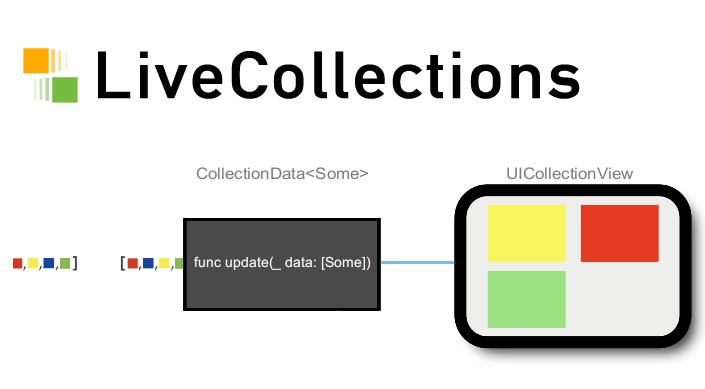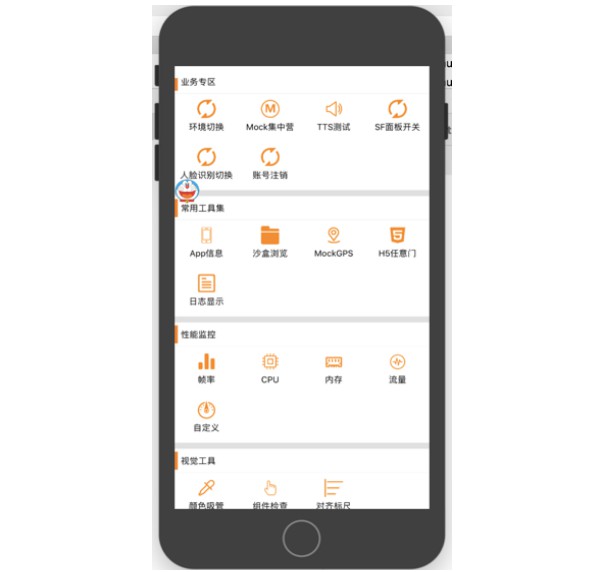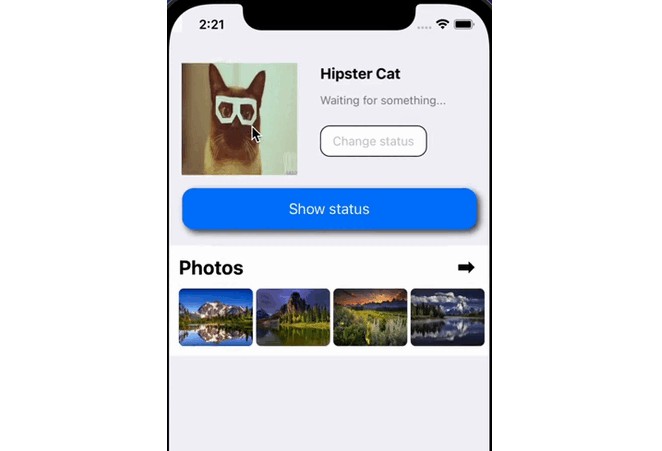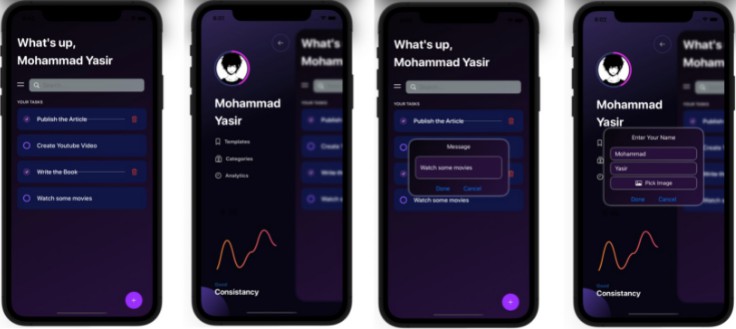LiveCollections
Automatically perform UITableView and UICollectionView animations between two sets of immutable data. It supports generic data types and is fully thread-safe.
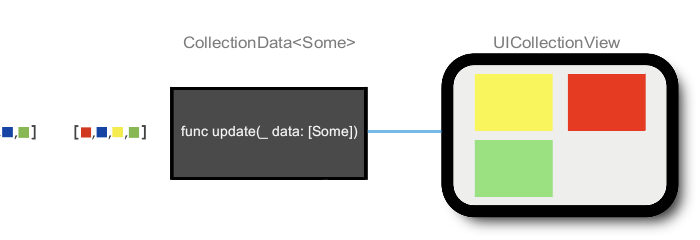
LiveCollections is an open source framework that makes using UITableView and UICollectionView animations possible in just a few lines of code. Given two sets of data, the framework will automatically perform all of the calculations, build the line item animation code, and perform it in the view.
Using one of the two main classes CollectionData or CollectionSectionData, you can build a fully generic, immutable data set that is thread safe, timing safe, and highly performant. Simply connect your view to the data object, call the update method and that's it.
In the sample app, there are a number of use case scenarios demonstrated, and the sample code of each one can be found by looking up the respective controller (e.g. ScenarioThreeViewController.swift).
Full detail for the use case of each scenario can be found in the blog post on Medium, which you can read if you want the full explanation. Below, I am just going to show the class graph and the minimum code needed for each case.
Importing With Carthage
github "scribd/LiveCollections" "beta_0.9.7"
Importing With CocoaPods
pod 'LiveCollections', '~> 0.9.7'
or
pod 'LiveCollections'
The Main Classes
- CollectionData<YourType>
- CollectionSectionData<YourSectionType>
By wrapping your data in one of these two classes, you can calculate a delta between your update and the current data set. If you assign a view to either object, then it will pass that delta and the data update to the view and perform the animation automatically. All updates are queued, performant, thread safe, and timing safe. In your UITableViewDataSource and UICollectionViewDataSource methods, you simply need to fetch your data from the CollectionData or CollectionSectionData object directly using the supplied count, subscript, and isEmpty thread-safe accessors.
To prepare your data to be used in CollectionData, you just need to adopt the protocol UniquelyIdentifiable.
The requirements for CollectionSectionData will be detailed in scenerios 5 and 6 a bit later on.
Adopting the protocol UniquelyIdentifiable
The crux of being able to use CollectionData as your data source and get all of the benefits of LiveCollections, is by adopting the protocol UniquelyIdentifiable. It's what allows the private delta calculator in the framework to determine all of the positional moves of your data objects.
public protocol UniquelyIdentifiable: Equatable {
associatedtype RawType
associatedtype UniqueIDType: Hashable
var rawData: RawType { get }
var uniqueID: UniqueIDType { get }
}
Since UniquelyIdentifiable inherits from Equatable, making your base class adopt Equatable gives you an auto-synthesized equatability function (or you can write a custom == func if needed).
Here's a simple example of how it can apply to a custom data class:
import LiveCollections
struct Movie: Equatable {
let id: UInt
let title: String
}
extension Movie: UniquelyIdentifiable {
typealias RawType = Movie
var uniqueID: UInt { return id }
}
Note: Take a look at Scenario 9 below to see an example where RawType is not simply the Self type. We will use a different type if we want to have different equatability functions for the same RawType object in different views, or if we want to create a new object that includes additional metadata.
Adopting the protocol NonUniquelyIdentifiable
Support has been added for non-unique sets of data as well.
public protocol NonUniquelyIdentifiable: Equatable {
associatedtype NonUniqueIDType: Hashable
var nonUniqueID: NonUniqueIDType { get }
}
By adopting this protocol and using one of the two type aliases NonUniqueCollectionData or NonUniqueCollectionSectionData, a factory will be built under the hood that will transform your non-unique data into a UniquelyIdentifiable type. See Scenarios 10 and 11.
Since the data is wrapped in a new struct, to access your original object you'll need to call the rawData getter like so:
let data = collectionData[indexPath.item].rawData
Note:This will use "best guess" logic, and the identifiers will be determined based on array order.
Listed below is a summation of the relevant code you'll need in your app for each of the scneario in the sample app. These reflect most of the use cases you will need when managing
Scenario 1: A UICollectionView with one section
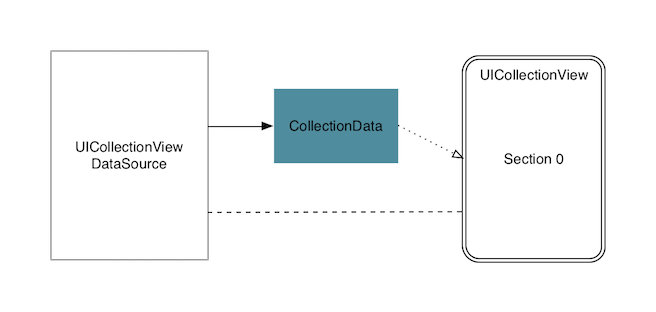
final class YourClass {
private let collectionView: UICollectionView
private let collectionData: CollectionData<YourData>
init(_ data: [YourData]) {
collectionData = CollectionData(data)
...
super.init()
collectionData.view = collectionView
}
func someMethodToUpdateYourData(_ data: [YourData]) {
collectionData.update(data)
}
}
extension YourClass: UICollectionViewDelegate {
func collectionView(_ collectionView: UICollectionView, numberOfItemsInSection section: Int) -> Int {
return collectionData.count
}
// etc
}
Scenario 2: A UTableView with one section
The same as scenario 1 but swap in UITableView.
Scenario 3: A UICollectionView with multiple sections, each section has its own CollectionData
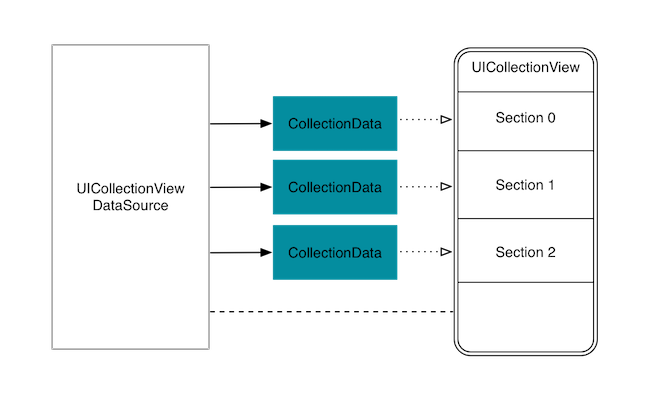
or
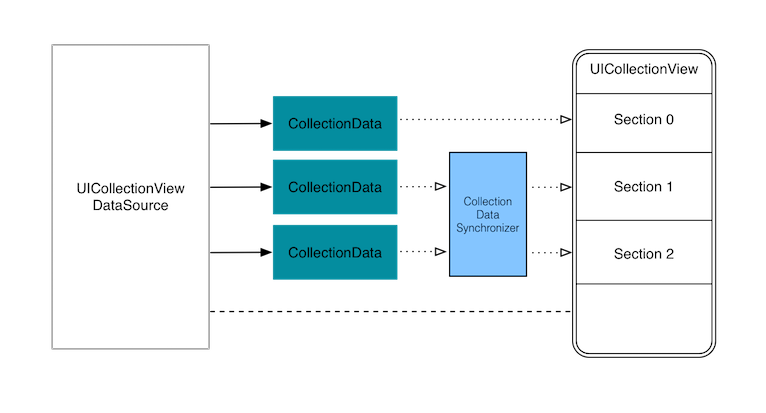
final class YourClass {
private let collectionView: UICollectionView
private let dataList: [CollectionData<YourData>]
init() {
// you can also assign section later on if that better fits your class design
dataList = [
CollectionData<YourData>(section: 0),
CollectionData<YourData>(section: 1),
CollectionData<YourData>(section: 2)
]
...
super.init()
// Optionally apply a synchronizer to multiple sections to have them
// perform their animations in the same block when possible
let synchronizer = CollectionDataSynchronizer(delay: .short)
dataList.forEach { $0.synchronizer = synchronizer }
}
func someMethodToUpdateYourData(_ data: [YourData], section: Int) {
let collectionData = dataList[section]
collectionData.update(data)
}
}
extension YourClass: UICollectionViewDelegate {
func numberOfSections(in collectionView: UICollectionView) -> Int {
return dataList.count
}
func collectionView(_ collectionView: UICollectionView, numberOfItemsInSection section: Int) -> Int {
let collectionData = dataList[section]
return collectionData.count
}
// let item = collectionData[indexPath.row]
// etc
}
Scenario 4: A UITableView with multiple sections, each section has its own CollectionData
The same as scenario 3 but swap in UITableView.
Using unique data across multiple sections? Adopt the protocol UniquelyIdentifiableSection
When data items are uniquely represented across the entire view, they may move between sections. To handle these animations, you can instead use CollectionSectionData and create a data item that adopts UniquelyIdentifiableSection.
public protocol UniquelyIdentifiableSection: UniquelyIdentifiable {
associatedtype DataType: UniquelyIdentifiable
var items: [DataType] { get }
}
As you can see, it still ultiately relies on the base data type that adopts UniquelyIdentifiable. This new object helps us wrap the section changes.
Note: Since UniquelyIdentifiableSection inherits from UniquelyIdentifiable, that means that each section will also require its own uniqueID to track section changes. These IDs do not have to be unique from those of the underlying items: [DataType].
import LiveCollections
struct MovieSection: Equatable {
let sectionIdentifier: String
let movies: [Movie]
}
extension MovieSection: UniquelyIdentifiableSection {
var uniqueID: String { return sectionIdentifier }
var items: [Movie] { return movies }
var hashValue: Int { return items.reduce(uniqueID.hashValue) { $0 ^ $1.hashValue } }
}
Scenario 5: A UICollectionView with multiple sections and a singular data source
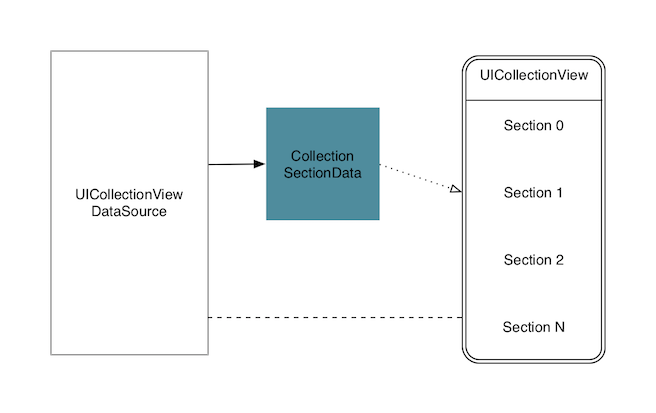
final class YourClass {
private let collectionView: UICollectionView
private let collectionData: CollectionSectionData<YourSectionData>
init(_ data: [YourSectionData]) {
collectionData = CollectionSectionData(data)
...
super.init()
collectionData.view = collectionView
}
func someMethodToUpdateYourData(_ data: [YourSectionData]) {
collectionData.update(data)
}
}
extension YourClass: UICollectionViewDelegate {
func numberOfSections(in collectionView: UICollectionView) -> Int {
return collectionData.sectionCount
}
func collectionView(_ collectionView: UICollectionView, numberOfItemsInSection section: Int) -> Int {
return collectionData.rowCount(forSection: section)
}
// let item = collectionData[indexPath]
// etc
}
Scenario 6: A UITableView with multiple sections and a singular data source
The same as scenario 5 but swap in UITableView (I bet you didn't see that coming).
Scenario 7: A Table of Carousels
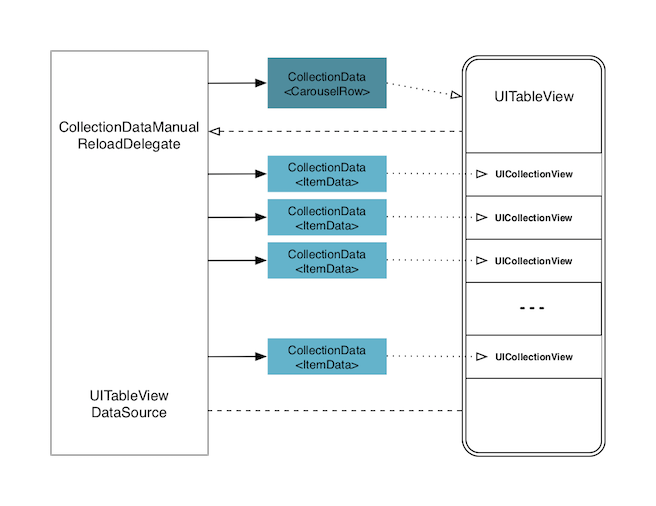
Table view data source
final class YourClass {
private let tableView: UITableView
private let collectionData: CollectionData<YourData>
private let carouselDataSources: [SomeCarouselDataSource]
init(_ data: [YourData]) {
collectionData = CollectionData(data)
...
super.init()
collectionData.view = tableView
}
func someMethodToUpdateYourData(_ data: [YourData]) {
collectionData.update(data)
}
// some function that fetches a carousel data source based on identifier
private func _carouselDataSource(for identifier: Int) -> SomeCarouselDataSource {
....
}
}
extension YourClass: UITableViewDelegate {
func tableView(_ tableView: UITableView, cellForRowAt indexPath: IndexPath) -> UITableViewCell {
// hook up SomeCarouselDataSource to the cell containing the collection view
// ideally wrap this logic into a private func rather than exposing these variables
...
let carouselRow = collectionData[indexPath.row]
let carouselDataSource = _carouselDataSource(for: carouselRow.identifier)
cell.collectionView.dataSource = carouselDataSource
cell.collectionView.delegate = carouselDataSource
carouselDataSource.collectionData.view = cell.collectionView
...
}
// etc
}
extension YourClass: CollectionDataManualReloadDelegate {
// IndexPathPair is a struct that contains both the source index path for the original data set
// and the target index path of the updated data set. You may need to know one or both pieces
// of information to determine if you want to handle the reload.
func willHandleReload(at indexPathPair: IndexPathPair) -> Bool {
return true
}
func reloadItems(at indexPaths: [IndexPath], indexPathCompletion: @escaping (IndexPath) -> Void) {
indexPaths.forEach { indexPath in
let carouselRow = collectionData[indexPath.item]
let carouselDataSource = _carouselDataSource(for: carouselRow.identifier)
let itemCompletion = {
indexPathCompletion(indexPath)
}
carouselDataSource.update(with: carouselRow.movies, completion: itemCompletion)
}
}
func preferredRowAnimationStyle(for rowDelta: IndexDelta) -> AnimationStyle {
return .preciseAnimation
}
}
A table view cell to contain the collection view
final class CarouselTableViewCell: UITableViewCell {
private let collectionView: UICollectionView
...
}
Carousel data source
final class SomeCarouselDataSource: UICollectionViewDelegate {
private let collectionView: UICollectionView
private let collectionData: CollectionData<YourData>
func someMethodToUpdateYourData(_ data: [YourData], completion: (() -> Void)?) {
collectionData.update(data, completion: completion)
}
}
extension SomeCarouselDataSource: CollectionDataReusableViewVerificationDelegate {
func isDataSourceValid(for view: DeltaUpdatableView) -> Bool {
guard let collectionView = view as? UICollectionView,
collectionView.delegate === self,
collectionView.dataSource === self else {
return false
}
return true
}
}
extension SomeCarouselDataSource: UICollectionViewDataSource {
func collectionView(_ collectionView: UICollectionView, cellForItemAt indexPath: IndexPath) -> UICollectionViewCell {
let cell = collectionView.dequeueReusableCell(withReuseIdentifier: SomeCarouselCell.reuseIdentifier, for: indexPath)
// NOTE: Very imporatant guard. Any time you need to fetch data from an index, first guard that it
// is the correct collection view. Dequeueing table view cells means that we can get into
// situations where views temporarily point to outdated data sources.
guard collectionView === collectionData.view else {
return cell
}
let item = collectionData[indexPath.item]
...
}
}
Scenario 8: A Sectioned Table of Carousels (carousels can move between sections)
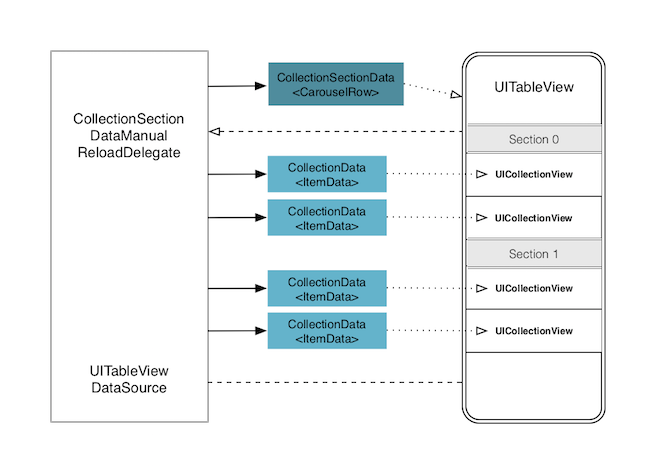
Almost everything is the same as the previous example, except that our table view uses CollectionSectionData.
final class YourClass {
private let tableView: UITableView
private let collectionData: CollectionSectionData<YourSectionData>
private let carouselDataSources: [SomeCarouselDataSource]
...
}
Scenario 9: Using a Data Factory
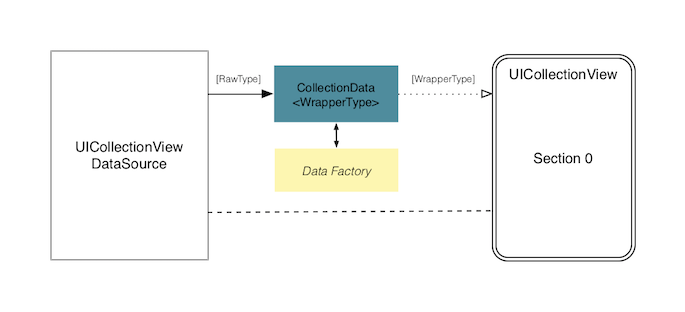
A data factory you build must conform to the protocol UniquelyIdentifiableDataFactory. It's role is to simply take in a value of RawType and build a new object. This can be as simple as a wrapper class that modifies the equatability function, or could be a complex factory that injects multiple data services that fetch metadata for the RawType item.
What using a data factory means is that your update method on CollectionData takes in [RawType], but returns a value of [UniquelyIdentifiableType] (your new data class) when requesting values via subscript. This also saves your data source from needing to know about any custom types you are building to customize your view.
The buildQueue property will default to nil via an extension, and is only needed if your data needs to be build on a specific thread. Otherwise ignore it.
public protocol UniquelyIdentifiableDataFactory {
associatedtype RawType
associatedtype UniquelyIdentifiableType: UniquelyIdentifiable
var buildQueue: DispatchQueue? { get } // optional queue if your data is thread sensitive
func buildUniquelyIdentifiableDatum(_ rawType: RawType) -> UniquelyIdentifiableType
}
Here is the example I use in the sample app. It takes in an injected controller that looks up whether a movie is currently playing in theaters, and creates a new object that includes this data. The equatability function includes this metadata, and thus changes the conditions of what constitutes a reload action in the view animation.
import LiveCollections
struct DistributedMovie: Hashable {
let movie: Movie
let isInTheaters: Bool
}
extension DistributedMovie: UniquelyIdentifiable {
var rawData: Movie { return movie }
var uniqueID: UInt { return movie.uniqueID }
}
struct DistributedMovieFactory: UniquelyIdentifiableDataFactory {
private let inTheatersController: InTheatersStateInterface
init(inTheatersController: InTheatersStateInterface) {
self.inTheatersController = inTheatersController
}
func buildUniquelyIdentifiableDatum(_ movie: Movie) -> DistributedMovie {
let isInTheaters = inTheatersController.isMovieInTheaters(movie)
return DistributedMovie(movie: movie, isInTheaters: isInTheaters)
}
}
Once you build your factory, the only real change to your code is injecting it into the initializer:
final class YourClass {
private let collectionView: UICollectionView
private let collectionData: CollectionData<Movie>
init(_ movies: [Movie]) {
let factory = DistributedMovieFactory(inTheatersController: InTheatersController())
collectionData = CollectionData(dataFactory: factory, rawData: movies)
...
super.init()
collectionData.view = collectionView
}
func someMethodToUpdateYourData(_ movies: [Movie]) {
collectionData.update(movies)
}
}
extension YourClass: UICollectionViewDelegate {
func collectionView(_ collectionView: UICollectionView, numberOfItemsInSection section: Int) -> Int {
return collectionData.count
}
func collectionView(_ collectionView: UICollectionView, cellForItemAt indexPath: IndexPath) -> UICollectionViewCell {
...
// note the different type being returned
let distributedMovie = collectionData[indexPath.item]
...
}
// etc
}
Scenario 10: Non-unique data in a single section
Use the typealiased data struct NonUniqueCollectionData with your non-unique data.
final class YourClass {
private let collectionView: UICollectionView
private let collectionData: NonUniqueCollectionData<YourData>
init(_ data: [YourData]) {
collectionData = CollectionData(data)
...
super.init()
collectionData.view = collectionView
}
func someMethodToUpdateYourData(_ data: [YourData]) {
collectionData.update(data)
}
}
extension YourClass: UICollectionViewDelegate {
func collectionView(_ collectionView: UICollectionView, numberOfItemsInSection section: Int) -> Int {
return collectionData.count
}
func collectionView(_ collectionView: UICollectionView, cellForItemAt indexPath: IndexPath) -> UICollectionViewCell {
...
// note that your data is wrapped in a unique type, it must be fetched with rawData
let movie = collectionData[indexPath.item].rawData
...
}
// etc
}
Scenario 11: Non-unique data in multiple sections
Use the typealiased data struct NonUniqueCollectionSectionData with your non-unique section data.
final class YourClass {
private let collectionView: UICollectionView
private let collectionData: NonUniqueCollectionSectionData<YourSectionData>
init(_ data: [YourSectionData]) {
collectionData = CollectionData(view: view, sectionData: data)
...
super.init()
}
func someMethodToUpdateYourData(_ data: [YourData]) {
collectionData.update(data)
}
}
extension YourClass: UICollectionViewDelegate {
func collectionView(_ collectionView: UICollectionView, cellForItemAt indexPath: IndexPath) -> UICollectionViewCell {
...
// note that your data is wrapped in a unique type, it must be fetched with rawData
let movie = collectionData[indexPath.item].rawData
...
}
// etc
}
Scenario 12: Manual timing of the animation
In every previous case we have assigned the view object to the CollectionData object. If you choose to omit this step, you can still get the benefits of LiveCollections caltulations.
Simply do the following:
let delta = collectionData.calculateDelta(data)
// perform any analysis or analytics on the delta
let updateData = {
self.collectionData.update(data)
}
// when the time is right, call...
collectionView.performAnimations(section: collectionData.section, delta: delta, updateData: updateData)
Note: This is unavailable for CollectionSectionData as the animations occur in multiple steps and the timing of the updates is very specific.
